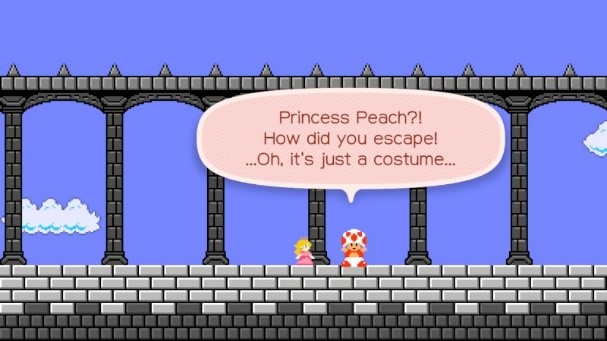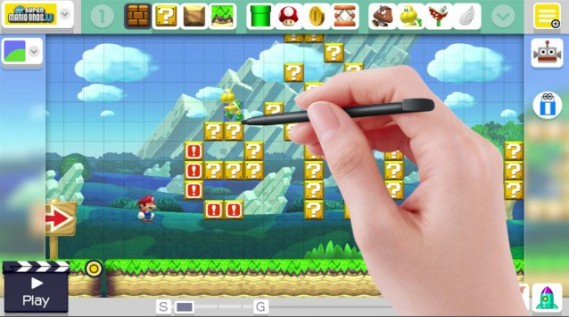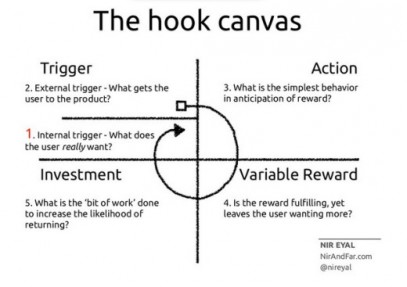1. Examine the informational structure and interactive possibilities of ONE piece of ‘conditional design’ (game, narrative, collaborative process) of your choice. Explore these as examples of interaction, with particular reference to the role of the audience & designer in each.
This essay will explore the informational structure and interactive possibilities of a side-scrolling platform video game Super Mario Maker (2015), in relation to the role of both audience and designer. Super Mario Maker is a great example in this case of discussion considering it is a game creator application for the Wii U/3DS. The game allows Players to design their own course by inserting the original game elements such as blocks, enemies and items. Therefore, it can be argued that the player (audience) is the designer of the game, or vice versa. By the aspects of the game, information (narrative) and interaction possibilities can be affected by the designer/player themselves. The gamified features of the game will also be analysed to find out how it applies to an effective interaction design.
The game concept is different in comparison to previous Super Mario Bros series (also developed and published by Nintendo), however the main objective is still the same. The player character, Mario, jumps on the platform and enemies while avoiding their attacks and advances to the right of the scrolling screen. The game level has single exit objectives, which must be reached within a certain time limit and lead to the next sequence. The ultimate goal is to progress through levels by defeating enemies, collecting items/power ups and solving puzzles without dying.
The game begins with a creative interactive title screen which consists of two choices that enables players to choose from, “Create” or “play”. The Create option allows players to create and edit their own stage, whilst the play option enables players to choose either Course world (Online mode) or 10 Mario challenge (Storyline mode). The creator/designer of the game decides to offer options for Audience/players to select different game modes. Andy Cameron is a creative director in interaction design, he believes that interaction offers the audience choices, it places the audience in relation to information. In this case, players can either create and control their own game play pathway or play pre-made stages that follows a narrative produced by other designers. During the title screen, a randomly generated course/stage will appear in the background for players to control their characters on the screen. Each letter will generate a different effect on the game title screen. For example, pressing the letter K will turn the screen into a sepia tone. The music for the title will also turn into an 8-bit variation. Players can even complete the stage before starting any game mode. Although the effect choices are limited, players can still choose to set their favourite title screen rather than sticking to one theme style by the designer of the game.
(Example of title screen changes. Super Mario Wiki User – Crazyman14, 2015)
In 10 Mario Challenge, the goal is to clear 8 randomly generated courses created by Nintendo Staffs, with 10 lives. Course World (online mode) is the game’s dedicated way to share their course creations with the rest of the user base. Player in the course world can choose to play any of the uploaded level, allowing online interaction between players around the world. The Course World also features a 100 Mario challenge mode, which gives the player 100 Mario lives to clear a certain number of user-generated courses, depending on the difficulty.
The informational structure is also known as the gameplay in gaming context. It is how player interact and communicate with the information they received from a game. Player has full control over an avatar in the game, how the avatar moves depend on how player respond to the information they see in the course. For example, exploring the course environment, jumping on enemies, solving puzzles. Super Mario Maker still follows a generic Mario game narrative. Before the player begins the first level of 100 Mario Challenge mode, Peach (Princess of the fictional Mushroom Kingdom) makes an appearance, and is kidnapped by two Goombas (Antagonist). After the completion of the challenge, Mario (Protagonist) rescues Peach. The process/journey of the challenge is what the player actually experience in the game. New media (game) should contain a narrative. “It should be a series of connected events caused or experienced by actors” (Mieke Bal – 1885), the actor in this game context is Mario.
Although Super Mario Maker isn’t a RPG theme game, the challenge mode process is still interactive because it has a non-linear narrative. The result of Challenge mode is based on how players progress different levels. If Mario is unable to reach the last level with 100 lives, players will have to start again from the beginning of the mode. Therefore, the result will be different depending on the player’s actions throughout the mode. Every level is user generated, this means that Mario is placed in an unfamiliar environment in every course. Players will then have the freedom to explore it and will have a predefined path to follow, the path itself may not necessarily be linear, but it always leads Mario to the next important destination. Another example is during the gameplay of a level. It is the player’s choice to decide whether Mario should go through the green pipe to access a different area of the level or if Mario should break the random item block for unexpected power up, which can result in a different ending of the level.
(Different dialogue ending as Mario plays the challenge mode with a different costume. Lucas Thomas, 2015)
In addition to the Play mode, Super Mario Maker presents its unique game mode, Create.
The designer of the game came up with an idea to open their own level-designing tool to the masses, which is extremely simple to use. As a result, players can enjoy an almost never ending Mario game that doesn’t feel repetitive. In the “Create” mode, players are able to edit levels by using a Wii U gamepad. The game’s level editor is intuitive and satisfying, even for players who have no experience in level design. Players in this scenario of game mode is the designer, they can just tap play and try it out, then go back into editor and adjust the course to their satisfaction. From the gamified aspects of Super Mario Maker’s design, it’s related to the idea of effectiveness in gamification as it applies to interaction design. “Design intuitively is one of the key element for a successful interaction design” – (Zack Rutherford, 2015). It allows player to learn designing through interaction with the interface. Editing mode is a simple system that utilizes a user-friendly interface of dragging and dropping different items from the menu bar into the environment. Course Creator starts out from scratch with no elements placed on the screen, and has little or no sense of purpose. Yet every action/interaction a player makes develops the interface and gives more information to how the creator is supposed to proceed. “Learning by playing games according to this view is a process of constant practice and interaction in progressively more challenging tasks through which players gradually reveal underlying sets and systems of rules.” – (Richard Sandford, 2005)
The whole editing process follows these simple steps. The left panel of interface is to choose the game style of a whole level or of the certain section, users can decide to change the styles for different sections. The style is the visual and gameplay style, choices including the classic 8-bit styles from the first Super Mario Bros, the 16-bit graphics of Super Mario World, or the 3D vectors from New Super Mario Bro U. The upper menu is to drag and drop game elements. Other unique attributes could be added, such as sound effects and certain graphical elements like fireworks, auto-scrolling feature as well as different time limit. Controlling the in-game character while editing will leave traces to help creator decide where to put the next element. A course bot is on the right panel where creator can save and upload levels. On the bottom of the screen, there’s a stretching meter to adjust the length of a given level section. With all these tools and elements, players/creators can create their own informational structure of the game, making it highly interactive. “Interactivity means the ability to intervene in a meaningful way within the representation itself, to "(re)make" it differently” (Andy Cameron 2008). The player/creator clearly demonstrates an active participation to the control of the game.
(User Interface of the create mode. Kiwisgamereviews, 2015)
Video games are designed to be fun, immersive and addictive (Zack Rutherford, 2005). In order for players to fully interact with the game, designers have to consider the gamification value in Super Mario Maker to attract them to participate and engage within the game.
“Play is to somebody an engaging activity in which the player believes to have active participation” (Gonzalo Frasca, 2007, Play the message).
Nir Eyal, who is a product design expert, he stated that all great habits hook user through four interconnected phases, these 4 aspects are required in an effective gamified interaction design. The first phase is called Cues (or triggers), it is the visual information that prompts a game player into action. The game interface is the main visual element that communicates information with the user. It draws users to the product (game) because of the visual difference of the user interface in comparison to other Super Mario Bros series. The create mode user-interface is what brings the user into action from all the information they receive. The second phase is routines (or actions), this is what the player actually does in the game. As mentioned, Super Mario Maker provides 2 game mode options, create and play. The objective is as conventional as fighting monsters, solving puzzles in particular.
The third phase is reward, tangible rewards for instance, levelling up and unlocking achievements, while intangible rewards could possibly be visual delight of advanced graphics and fun gameplay. Tangible reward in this game example consists of unlocking editing tools, in which a set of course elements will be available gradually, with new elements unlocking as the player spends more time creating courses. Other rewards include new sample course sets, over 100 character costume sets by completing challenges. The last phase of the art of hooking users is Investment, an example is when players strengthen their character, and they become personally invested in the game’s final outcome. In this case, players can advance game design skills by creating user friendly courses. Players are free to upload up to 10 courses online at first but by receiving stars from other players, they can earn medals which allow them to upload more courses. The more medals they received by online players and the higher rank they will be on online Maker rankings. The stats/skills of the in-game character does not improve as you progress, except players can custom their in-game character to the costume they have earned through challenges to flaunt their gameplay skills. Super Mario Maker is related to the hook canvas theory which makes it an effective gamified interaction design that clue user into the actions for which they’ll be rewarded. “The experience won’t occur if the audience doesn’t engage it” – (Brandon Rickman)
(Hooked by Nir Eyal)
This essay examined the informational structure and interactive possibilities in relation to the role of both, the player and the designer of Super Mario Maker. By exploring the two gameplay modes from the game, I have concluded that the maker of the game greatly provide opportunities for audience to participate with the gaming experience by being a player and creator themselves, making it highly interactive. Not only can the player interact with the game story, but also with online players around the world. Through the analysis of successful gamification aspect of the game, I have realised that the maker of the game has produced pleasurable user interface for player to interact. User Interface is intuitive which brings player to engage with the narrative and/or game mechanic enough for them to learn new interaction patterns easily.
Bibliography
1. Andy Cameron (26 September 2008). Dissimulations: The illusion of Interactivity, The interactive story. http://www.metamute.org/editorial/articles/dissimulations
2. Ara Shirinian (10 June 2015). What is a good video game interaction design? http://shirinian.net/writings/games.html
3. Brian NE (17 June 2015). Super Mario Maker – Details about online interactions. http://nintendoeverything.com/super-mario-maker-details-about-online-interactions/
4. Eric Zimmerman (2003). Re:Play: Game Design + Game Culture, 13 – 15
5. Gonzalo Frasca (2007). Play the Message: Play, Game and Videogame Rhetoric: A new general definition of play, 50 – 57
6. Jamie Banks (11 Oct 2016). Player and Avatar: Video game interactions for web UX designers: Player-Avatar Relationships, Explained.
7. Kyle Orland (2 September 2015). Super Mario Maker pulls the curtain back on game design’s promise and peril: A magical, intuitive interface. http://arstechnica.co.uk/gaming/2015/09/super-mario-maker-not-everyone-can-be-miyamoto-but-everyone-can-try/
8. Lev Manovice (2001). The language of new media: Database and Narrative, p227 http://www.uxbooth.com/articles/player-and-avatar-video-game-interactions-for-web-ux-designers/
9. Richard Sandford (2005). Games and Learning: Learning from playing games outside school, p4
10. Sergey_3847 (10 September 2015). Everything you need to know about Super Mario Maker: Create Mode, Play Mode. http://www.gameskinny.com/2djg8/everything-you-need-to-know-about-super-mario-maker
11. Zack Rutherford (7 October 2015). How video games improve your interaction design: The art of hooking users, what works in gamification. http://thenextweb.com/dd/2015/10/07/how-video-games-improve-your-interaction-design/



